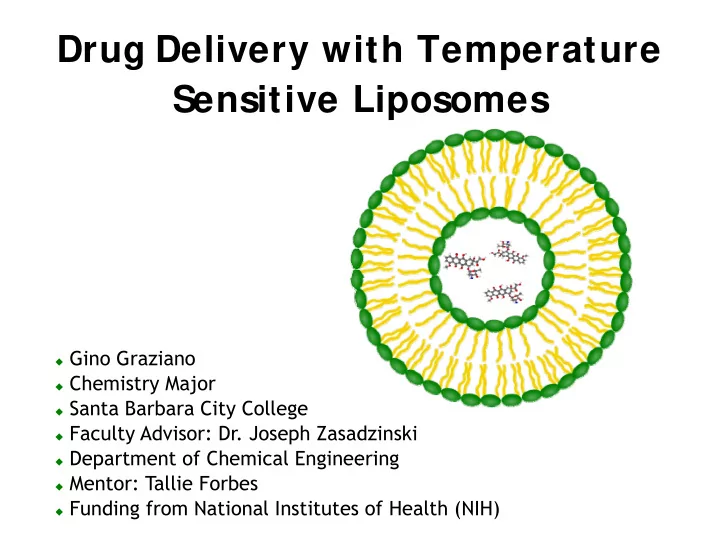

Drug Delivery wi ith Temperature Sensitive L Liposomes Gino Graziano Chemistry Major Santa Barbara City College Santa Barbara City College Faculty Advisor: Dr. Joseph Zasad dzinski Department of Chemical Enginee ering Mentor: Tallie Forbes Mentor: Tallie Forbes Funding from National Institutes of Health (NIH)
Liposomes and Mecha Liposomes and Mecha anism anism Phospholipid bilayer (cell mem mbrane material) Water-compatible head Water compatible head Water-incompatible tail Distinguishing Characteristic Distinguishing Characteristic Naturally aggregates in “leaky” cancer tissue Mechanism: Temperature Sensitive Temperature Sensitive Drug permeates membrane and is (releases contents at ~40 ° C) encapsulated
Big Picture g More effective cancer trea atments by using temperature sensitive liposomes as vehicl p les for chemotherapy drugs py g Tumor Tumor Current Chemotherapy Liposome Delivery Dispersed Dispersed Targeted Targeted Limited dosages Larger effective dosage Wide range of adverse effects Reduced adverse effects Controlled release Controlled release
Research Goals What loading conditions giv ve the highest encapsulation efficiency? amount of drug encapsulated encapsulation efficiency = = total drug added to sample g p Variables pH gradient ( Δ pH) pH gradient ( Δ pH) Temperature Time Concentrations
Using gold nanoshells for co Using gold nanoshells for co ontrolled release ontrolled release M Mechanism M h i 1) ) Tethering of nanoshells to liposome 2) 2) ) Irradiation with near infrared laser ) Irradiation with near-infrared laser 3) ) Liposome is heated to release temperature 4) ) Drug is released Go old nanoshell Polymer tethers
Method: Fluorescence Method: Fluorescence e Spectroscopy e Spectroscopy Measuring concentration of d rug through fluorescence intensity through fluorescence intensity y Generally, intensity is directly related to concentration: related to concentration: I = kC Proportionality constant constant Fluorescence is measured before and after rupturing b f d ft t i Chal llenges loaded liposomes Phot todecomposition Self S lf -quenching hi g Che mical interaction
Preliminary Results: E Preliminary Results: E Encapsulation Encapsulation Change in fluorescence intens sity ( Δ I) is indicative of how much drug was encapsulat how much drug was encapsulat ted ted Increased pH Gradient Increased Loading Time 30.0 30.0 20.0 20.0 ∆ I ∆ I 10.0 10.0 0.0 0.0 2 hrs 16.5 hrs 3.4 4.4 Loading time ∆ pH I Increased Drug Amount d D A t I Increased Loading Temperature d L di T t 20.0 80.0 60.0 10.0 40.0 ∆ I Δ I 20.0 0.0 0.0 2.5 μ L 7.5 μ L 20°C 35°C Amount of drug added Loading temperature
Method Comparison 120.0 Two loading schemes used 90.0 Double buffer method Manually established pH Δ I 60.0 gradient gradient 30.0 Ion gradient method Passively established pH 0 0 0.0 gradient Same conditions Summary Increases in encapsulation seen when: h pH gradient is increased Ion gradient loading shows Loading time is increased to be much more efficient to be much more efficient Loading temperature is increased L di t t i i d Drug to lipid ratio is increased
Preliminary Results: R Preliminary Results: R Release Release Loaded liposomes irradiated with near-infrared laser Without Nanoshells Without Nanoshells With Nanoshells With Nanoshells 30000 12000 Intensity Intensity 20000 20000 8000 8000 10000 4000 0 0 Bulk Temperature : 37 ± 1 ° C ure: 40 ° C 78.71% Release Release Temperat 78 71% Release
Conclusions Conclusions Increasing encapsulation tren g p nd with increasing loading time, temperature, p H gradient and drug/lipid ratio Ion gradient loading much m ore effective Significant release observed g with nanoshells, suggests , gg relatively effective nanoshell tethering
Future Work: Future Work: Leakage measurement L k t Comparative release with d different tethering methods More encapsulation data sp More encapsulation data, sp pecifically regarding pecifically regarding time and concentration
Acknowledgments Acknowledgments Tallie e Forbes Dr. Joseph h Zasadzinski The Zasa adzinski Lab Dr. Jens s-Uwe Kuhn Dr Nich Dr. Nich holas Arnold holas Arnold Dr. Ar rica Lubin
Ion Gradient Method Ion Gradient Method (NH 4 ) 2 SO 4 NH 3 + + NH 4 HSO 4 U ncharged (leaves the liposome) Further equilibria: NH 4 HSO 4 NH SO H 3 + H 2 SO 4 SO H 2 SO 4 H + + + HSO 4 - Acidification of interior H + + HSO 4 - + SO 4 2-
Recommend
More recommend